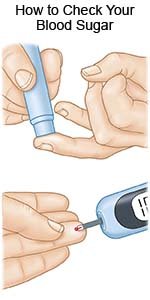How to Check your Blood Sugar
Medically reviewed by Drugs.com. Last updated on Apr 6, 2025.
How do I check my blood sugar?
You will be taught how to check a small drop of blood with a glucose meter. Get all of your supplies together, such as your meter, test strips, and lancet device. Be sure to read the information that came with your meter. Use the following steps as a guide:
- Wash your hands. Use warm water to help blood flow. Dry your hands completely.
- Put the test strip in the meter. This will turn on your meter.
- Use the lancing device to stick your finger or area. Do not use the same finger or area every time. Stick the side of your fingertip, not the middle. The side may cause less pain.
- Squeeze your fingertip or area gently.
- Touch the drop of blood to the test strip. A number will appear on the meter after a few seconds. This is your blood sugar level.
-

When should I check my blood sugar?
Your healthcare provider will tell you when and how often to check during the day.
- You may need to check your blood sugar level at least 3 times each day.
- If you check your blood sugar level before a meal , it will show you your lowest blood sugar. If you check your blood sugar level 2 hours after a meal , it will show you your highest blood sugar. Ask your healthcare provider what good goals for your blood sugar levels are at different times.
- You may need to check for ketones in your urine or blood if your blood sugar level is higher than directed.
- Write down your results and show them to your healthcare provider at every visit. Your provider may use the results to make changes to your medicine, food, or exercise schedules.
Have someone call 911 for any of the following:
- You cannot be woken.
- You have chest pain or shortness of breath.
When should I seek immediate care?
- You have a low blood sugar level and it does not improve with treatment.
- Your blood sugar level is above 240 mg/dL and does not come down after you take a dose of insulin.
- You have ketones in your blood or urine.
- You have blurred or double vision.
- Your breath has a fruity, sweet smell, or your breathing is shallow.
- You have symptoms of a low blood sugar level, such as trouble thinking, sweating, or a pounding heartbeat.
When should I contact my healthcare provider?
- Your blood sugar levels are higher than your target goals.
- You often have low blood sugar levels.
- You have trouble coping with your illness or you feel anxious or depressed.
- You have questions or concerns about your condition or care.
Care Agreement
You have the right to help plan your care. Learn about your health condition and how it may be treated. Discuss treatment options with your healthcare providers to decide what care you want to receive. You always have the right to refuse treatment. The above information is an educational aid only. It is not intended as medical advice for individual conditions or treatments. Talk to your doctor, nurse or pharmacist before following any medical regimen to see if it is safe and effective for you.© Copyright Merative 2025 Information is for End User's use only and may not be sold, redistributed or otherwise used for commercial purposes.
Further information
Always consult your healthcare provider to ensure the information displayed on this page applies to your personal circumstances.
